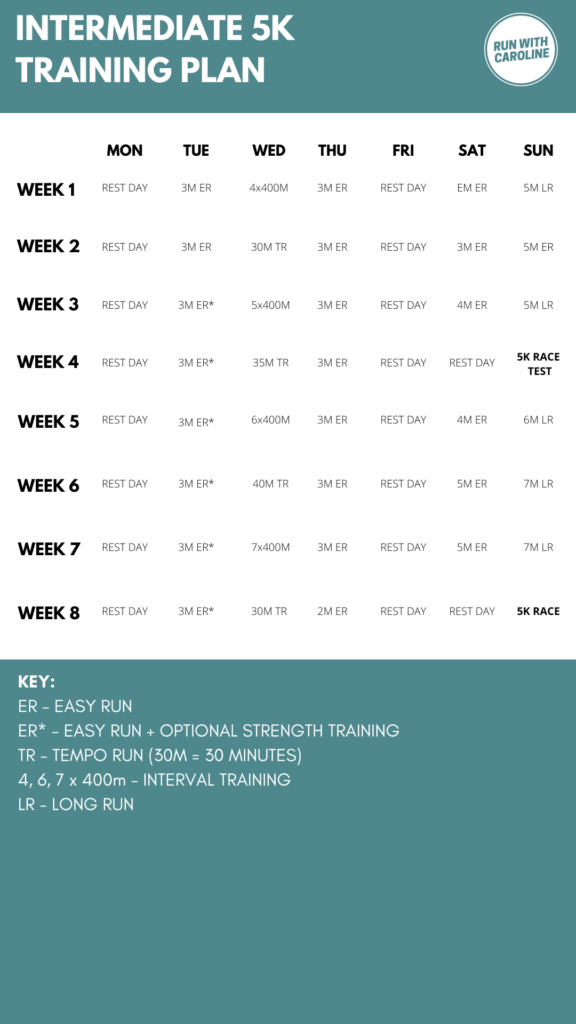If you’re looking to get a personal best on your next 5k then this 8 week intermediate 5k training plan has got you covered!
It’s common for a lot of runners to want to run a faster 5k when they feel they have mastered the basics of running a 5k.
There are many articles out there that publicise the benefits of running a 5k.
Running shorter distances like a 5k regularly, as opposed to running longer distances like half marathons and marathons, can actually be better for you in the long term.
When it comes to running a 5k, you may already have a finish time in mind.
If it’s under 25 or 30 minutes then be sure to check out our guides on how to run a 5k in 25 minutes or less and how to run a 5k in 30 minutes or less for tips on how to get your next PB.
This intermediate 5k training plan will provide you with a framework to smash your next 5k race!
In this guide, we’ll explore:
- How long is a 5k?
- What is a good 5k time?
- Who should be using this intermediate 5k training plan?
- What’s included in the plan?
- 4 tips for running a 5k
- Intermediate 5k training plan: Week by week plan
Ready?
Let’s get started!

How long is a 5k?
A 5k in miles is 3.1 miles.
Related: How many miles is a 5k? Average 5k times
What is a good 5k time?
The average time to run a 5k across all ages and genders is 23:58.
For men, the average time to run a 5k is 22:31.
For women, the average time to run a 5k is 26:07.
Related: What is a good 5k time? Average 5k times by age and gender
Who should be using this intermediate 5k training plan?
This intermediate 5k training plan is for you if:
- You’ve run a 5k multiple times.
- You’ve been training for a 5k for a while but you’re not seeing any improvements in your times.
- You’re ready to take your training up a notch in your pursuit of a faster 5k.
- You can comfortably run for 30 minutes without stopping or getting out of breath.
If you feel you’re not quite ready for this intermediate 5k training plan, then check out our beginner 5k training plan.
Related: How to run a 5k in 25 minutes or less

What’s included in the plan?
A well-rounded training plan will include a range of different runs and workouts to ensure you are able to run at a faster pace on race day.
In particular, this plan will help you to improve your endurance, strength and speed – three things that are crucial to focus on when training for a faster 5k.
The training plan includes the following runs and workouts each week:
- 3 easy runs
- 1 long run
- 1 speed training session
- 1 optional strength training session
- 2 rest days
Easy runs
The plan will include easy runs which are runs where you run at a comfortable pace.
The general rule of thumb is that you should be able to hold a conversation while you run without getting out of breath.
Easy runs are designed to be just that – easy!
Long run
The plan will also include one long run a week that is between 5-7 miles.
Long runs are still important when it comes to training for a 5k as they help to build your endurance and stamina.
Make sure you run at a comfortable pace during your long run, they shouldn’t feel too challenging.
Speed training
Speed training is a way to increase your running speed and stamina.
This type of training can include strides, interval training, Fartlek training and tempo running.
This plan mainly focuses on interval training and tempo running, but you could switch these activities out for other speed training of your choice.
Tempo running
Tempo running, also known as threshold running, is a type of speed training that is designed to get you running outside of your comfort zone.
You will be running at a faster pace during these runs and therefore your body will get used to running at a faster pace.
Tempo runs are great for developing your anaerobic threshold.
Interval training
Interval training is another type of speed training included in the plan.
As with tempo running, in order to improve your speed you need to be running at a faster pace during training.
The plan includes 400m intervals separated by a recovery walk or jog.
Just remember to warm up thoroughly before attempting intervals – don’t go straight into doing them as you are at a higher risk of injury.
Strength training
This plan also includes time for optional strength training.
It’s up to you if you include strength training in your plan at this stage, but it is highly recommend for any runner looking to run faster and stronger for longer.
The plan includes strength training sessions scheduled after your easy run, but you can schedule these sessions on days that are better for you in terms of timing.
Rest days
Rest days are just as important as runs, so the plan won’t get you running every day of the week.
At most, you’ll be running 4 days a week.
Race test
At points in the plan you will be doing what is called a race test.
This is designed to test your fitness, normally half way through the plan, so you can understand how you’re doing and what you might need to calibrate to improve certain areas.
Stretching
Whilst not programmed in the plan, stretching is crucial in the recovery process and helps to alleviate soreness and DOMS (delayed onset muscle soreness).
Make sure you find time to stretch, particularly after fast runs. You may also want to include foam rolling into your recovery routine.
Related: 30 day strength training plan for runners

4 tips for running a 5k
Here are some tips for completing your 5k:
#1 Remember to warm up before each run
Dynamic stretches and running drills are great exercises to do as part of a warm up as they get your body prepared for the run ahead.
A warm up is especially important to do before an intense speed training session.
#2 Remember to cool down after each run
A cool down is equally as important as a warm up to ensure you reduce the risk of injury and allow your body to return to its pre-exercise state safely.
Aim to include some static stretches in your cool down.
#3 Fuel your body properly
In this plan you’ll be doing more ancillary work like strength training and speed training.
Therefore it’s important you fuel your body properly before each run and in between runs to replenish your energy stores.
Hydration is also a key indicator for performance, so make sure you’re drinking enough water to replace those fluids lost through sweat on your runs.
#4 Prioritise recovery
Rest and recovery is integral to any training plan, so make sure you use the rest days in this plan for precisely that – rest!
Cross training activities like walking, cycling, swimming and yoga are great additions to any training plan and can be done on ‘active recovery’ days.
Yoga in particular has many benefits for runners including increasing strength and mobility.
Related: How many miles is a 5k? Your essential guide to running a 5k

Intermediate 5k training plan: Week by week plan
Week 1
- Monday – Rest day
- Tuesday – 3 mile easy run
- Wednesday – 4 x 400m intervals
- Thursday – 3 mile easy run
- Friday – Rest day
- Saturday – 3 mile easy run
- Sunday – 5 mile long run
Week 2
- Monday – Rest day
- Tuesday – 3 mile easy run
- Wednesday – 30 min tempo run
- Thursday – 3 mile easy run
- Friday – Rest day
- Saturday – 3 mile easy run
- Sunday – 5 mile long run
Week 3
- Monday – Rest day
- Tuesday – 3 mile easy run + optional strength training
- Wednesday – 5 x 400m intervals
- Thursday – 3 mile easy run
- Friday – Rest day
- Saturday – 4 mile easy run
- Sunday – 6 mile long run
Week 4
- Monday – Rest day
- Tuesday – 3 mile easy run + optional strength training
- Wednesday – 35 min tempo run
- Thursday – 3 mile easy run
- Friday – Rest day
- Saturday – Rest day
- Sunday – 5k race test
Week 5
- Monday – Rest day
- Tuesday – 3 mile easy run + optional strength training
- Wednesday – 6 x 400m intervals
- Thursday – 3 mile easy run
- Friday – Rest day
- Saturday – 4 mile easy run
- Sunday – 6 mile long run
Week 6
- Monday – Rest day
- Tuesday – 3 mile easy run + optional strength training
- Wednesday – 40 min tempo run
- Thursday – 3 mile easy run
- Friday – Rest day
- Saturday – 5 mile easy run
- Sunday – 7 mile long run
Week 7
- Monday – Rest day
- Tuesday – 3 mile easy run + optional strength training
- Wednesday – 7 x 400m intervals
- Thursday – 3 mile easy run
- Friday – Rest day
- Saturday – 5 mile easy run
- Sunday – 7 mile long run
Week 8
- Monday – Rest day
- Tuesday – 3 mile easy run + optional strength training
- Wednesday – 30 min tempo run
- Thursday – 2 mile easy run
- Friday – Rest day
- Saturday – Rest day
- Sunday – 5k race
Intermediate 5k training plan PDF printable

- 5 things I wish I’d known before returning to running - March 3, 2024
- Running 20 minutes a day: Benefits + how to start - January 27, 2024
- How to run your first 2 hour half marathon - January 16, 2024

Paul
Monday 20th of March 2023
Hello Caroline - love your site. It's all laid out so clearly. I followed your intermediate training programme and got my first sub 25 min 5k! Very happy with the result, so thanks for your help with that.
I just have one question - what is the 5k race test? Is this a case of doing a warm up, and then doing the best 5k I am capable of at that time? Should I go for my ultimate target pace, or a little slower?
Caroline Geoghegan
Monday 20th of March 2023
Hi Paul. Thanks for your feedback. Glad you find it useful and congrats on the sub-25 minute 5k! The race test is a good time to test the waters. As we explain in the guide, the race test is designed to test your fitness, normally half way through the plan, so you can understand how you’re doing and what you might need to calibrate to improve certain areas. Aim to run the race test using your target race pace - you may find that you're able to meet the demands of this race pace, you may find you need a few more weeks' training to get up to speed (excuse the pun!) - this is completely fine. I wouldn't recommend doing any more race tests than the ones prescribed in the plan. Hope this helps.
ferdi
Saturday 3rd of December 2022
Good Evening Caroline Name is Ferdi how can I train for a 5 km in 26to 28 min can you help training programe
Nathan
Saturday 25th of September 2021
First off, excellent post and so much great stuff in there – rest is incredibly important, and it is how your body recovers that dictates everything. I think more and more things keep appearing that back that up, or at least that is what I have been reading. I think I tend to be happy with about one rest day and 50-55 miles in the winter and 60 or so in the summer. And whether or not that is optimal for me being a ‘better runner’, really doesn’t matter. It works great with my time and love of getting out there, and I feel great. I’m sure a coach would knock me upside the head and totally change things up on me, but I really don’t care. There are so many bloggers out there and it's hard to keep track of everyone! Thanks for this list and for including me! Check My recent post
haneet khanna
Friday 27th of November 2020
hi caroline. thanks for this.i ran a recent 5k in 30'40". based on this i have a few questions. 1.should i follow this plan to aim for a 25 min 5k? 2.what should be my pace for long runs? 3. whats the difference between and easy run and long runs apart from distance? do i follow the same pace as my easy run? 3. when you say 30 mins of tempo run does it include the warm up time or is it just the continuous tempo run at as in my case at a pace of 5'30" per km? 4. lastly should i calculate the paces based on goal time or current time of 5k?
thank you!
Erick
Wednesday 11th of November 2020
Hello! Thank you for creating the running plan! What does “Wednesday – 4 x 400m intervals “ mean? For example, pace, rests etc.
Caroline Geoghegan
Friday 13th of November 2020
Hi Eric. Interval training is another type of speedwork. The idea is you run at a faster pace during each interval. In terms of pace, you should not be able to hold a conversation whilst running during the interval. It should feel challenging and your breathing should feel laboured, but it's not a full out sprint. Each interval should be separated by a recovery walk or jog. Just remember to warm up thoroughly before attempting intervals – don’t go straight into doing them as you are at a higher risk of injury. Hope this helps :)